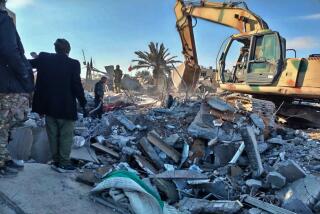Revamped Patriot System Downs 2 Missiles Aimed at U.S. Forces
- Share via
WASHINGTON — The controversial Patriot antimissile system intercepted two short-range Iraqi missiles Thursday as they hurtled across the Iraqi border toward U.S. forces in northern Kuwait, military officials said.
In all, five Patriot missiles were fired from Camp Thunder and nearby Ali al Salem air base, a Kuwaiti facility where U.S. forces are stationed, officers said. Two of the missiles landed harmlessly in the desert. Another malfunctioned and self-destructed, as designed.
The Patriot’s performance has been a matter of wide interest because an earlier, simpler version of the system failed to take out Iraqi Scud missiles in the Persian Gulf War. The Pentagon has since poured billions of dollars into the program, which has a key defensive role in the Pentagon’s war plan, protecting both U.S. troops and allies such as Israel.
For this campaign, the Pentagon has fielded both the Patriot Advanced Capability-2 (PAC-2) system and the newer Patriot Advanced Capability-3 (PAC-3), which has been hurried into the field with testing still incomplete.
One of the Iraqi missiles, launched near Basra, in southern Iraq, reportedly was knocked down by a Patriot fired from the desert about nine miles from Camp Thunder. A second Iraqi missile, also fired from the Basra area, reportedly was struck by a Patriot launched from Ali al Salem.
The Israeli newspaper Haaretz quoted Israeli defense officials as saying that the intercepted missiles were similar to Frog missiles, a widely used older tactical weapon that has a range of about 43 miles.
The Iraqi missile that struck near the Marines’ Camp Commando was identified as a CSSC-3 Seersucker cruise missile, which flies a few hundred feet above the ground and has a range of about 60 miles. The missile was probably not picked up by U.S. sensors because of its low flight path, military officials said.
While it is risky to judge a weapon’s performance on early combat reports, analysts said the Pentagon would be pleased if the Patriot destroys most of the missiles fired within its effective range.
“If they hit even half of the targets they’re fired at, that’s a big improvement over their performance in the Gulf War,” said Philip Coyle III, who was chief weapons tester for the Pentagon during the Clinton administration. In tests last year, the Patriot struck a target in three out of seven tries, and produced a “kill” in only two of those three hits, said Coyle, who is now an official of the Center for Defense Information, a nonprofit research group.
As of late Thursday, the Patriot had still not been tested in battle against the more daunting challenge of Iraqi Scud missiles, especially those tipped with chemical and biological warheads. Pentagon planners have long feared that Saddam Hussein will try to use Scuds against allied troops, and perhaps Israel.
Early reports from Kuwait on Thursday said the Patriot had intercepted at least one Scud. But allied officials later withdrew that claim.
The Scud has a range of about 425 miles and flies far faster and higher than the short-range Frogs. Although the United Nations prohibits Iraq from possessing missiles with a range greater than 90 miles, Hussein is believed to have up to two dozen of the liquid-fueled Scuds left in his inventory. Iraqi officials in Baghdad insisted Thursday that they do not possess any of the weapons.
Some analysts said they were puzzled why the Iraqis had not used more missiles against U.S. forces at the outset of the war, while U.S. troops have been massing in Kuwait and relatively vulnerable. Iraq is believed to have hundreds of short-range missiles, but they will be of little use as allied forces move into Iraq.
“Where are the Iraqi missiles?” asked John Pike, of GlobalSecurity.org, a Northern Virginia research organization. “That’s my question.”
Hussein may have little time in which to use missiles against Israel. To reach Israel, he must fire the Scuds from the western Iraq desert. But allied forces have made it a top priority to seize control of the area as soon as possible to prevent such an attack. Israeli media reported Thursday that U.S. forces were already searching for missile sites in the western Iraqi desert.
Kenneth M. Pollack, a former National Security Council aide and CIA analyst, speculated that Hussein intends to hold back on use of chemical and germ weapons until the final confrontation he seems to be seeking between U.S. and Iraqi forces around Baghdad.
Chemical artillery shells and missile warheads probably won’t be highly effective against U.S. forces because the troops are well protected and are able to strike back quickly against artillery batteries, Pollack said. In addition, the weapons are banned by the United Nations, and their use would alienate foreign governments that Hussein hopes may be able to protect him from the Bush administration.
Also, by holding back their use, he may hope to increase U.S. fears that the final battle around Baghdad will be a horrific one, with far more casualties than the White House is willing to accept, Pollack said at a Brookings Institution conference on Thursday.
More to Read
Sign up for Essential California
The most important California stories and recommendations in your inbox every morning.
You may occasionally receive promotional content from the Los Angeles Times.














